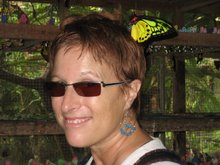The Citadel


The intersection below is typical of Vietnam traffic. Once in a while there is a traffic light, but not so often, and you can't count on vehicles stopping, traffic light or not. The strategy for crossing the street is to walk slowly across until you get to the other side. If traffic is lighter or going in pulses, you can try to move across without being mere feet away from looming large metal objects. In general, though, you just walk. Speeding up or stopping because something is coming right at you is often ill advised. Instead, it's kind of a zen thing. You just step off the curb and walk, and the traffic parts around you. It's actually not quite as scary as I had thought; kinda like getting on a plane and knowing your fate is out of your hands. You can sweat it or just go with it. After crossing, you step up on the curb and there's this feeling of accomplishment derived from making it through once again, with your whole life ahead of you!

 Billboards
Billboards
Auspicious Little Piggies (during the Year of the Golden Pig)

Saint Frances Xavier Church

Something for Kids of All Sizes, or, Guess Who Took This Picture

The Ho Chi Minh Museum in Hue



Hue Buddhist Monks and Students on Hunger Strike "Against America and Diem (the leader in the south)"

Ho Chi Minh was the leader of the communist revolution in Vietnam, and became Vietnam's Prime Minister and then President. Especially in the north, "Uncle Ho" is revered as the People's revolutionary. Southern Vietnamese still refer to Ho Chi Minh City (as it was named after Saigon fell) as Saigon and say it is only Ho Chi Minh City to the government, the north, and on maps. Many towns in Vietnam have Ho Chi Minh museums. Like southern Vietnamese and other Asian Buddhist businesses with their altars to Buddha, many businesses in northern Vietnam display portraits of Uncle Ho along with their ancestors. Like Abe Lincoln in the USA, stories abound about the integrity of Ho Chi Minh, who spoke much about the morality of the revolutionary and being a good example. Uncle Ho refused to live in the palace in Hanoi, preferring a simple wooden house on stilts on the same property as the palace. He saved the palace for entertaining dignitaries from other countries. When his followers surprised him with air conditioning in his modest home, he said that it would be wrong for him to live above the common man and had it removed. (We visited that home in Hanoi.)
It's interesting to hear history from the point of the "other side's" view. In northern Vietnam, the war museums refer to the US as "American imperialists" or "American dictatorship"; pictures of US soldiers are often those of the Americans "panicking" on the battlefield, surrendering, or being taken prisoners of war.

It's interesting to hear history from the point of the "other side's" view. In northern Vietnam, the war museums refer to the US as "American imperialists" or "American dictatorship"; pictures of US soldiers are often those of the Americans "panicking" on the battlefield, surrendering, or being taken prisoners of war.
Uncle Ho Chi Minh


Leaders of the World Proletarian Class

Uncle Ho's Clothing

Hue Buddhist Monks and Students on Hunger Strike "Against America and Diem (the leader in the south)"

We took a day trip out to the demilitarized zone, which didn't stay demilitarized for long. We went to the Ben Hai River, which was the physical boundary between the communist north and pro-western south, and part of the Ho Chi Minh Trail. We also went to a war museum at former US base camp and battleground Khe Sanh, as well as walking through one set of the tunnels and trenches where North Vietnamese civilians hid for years. I lost my camera containing pics of this. This site has a lot of the pics I took and more: http://www.globalgayz.com/VietNamDMZincludingKheSanh/



No comments:
Post a Comment